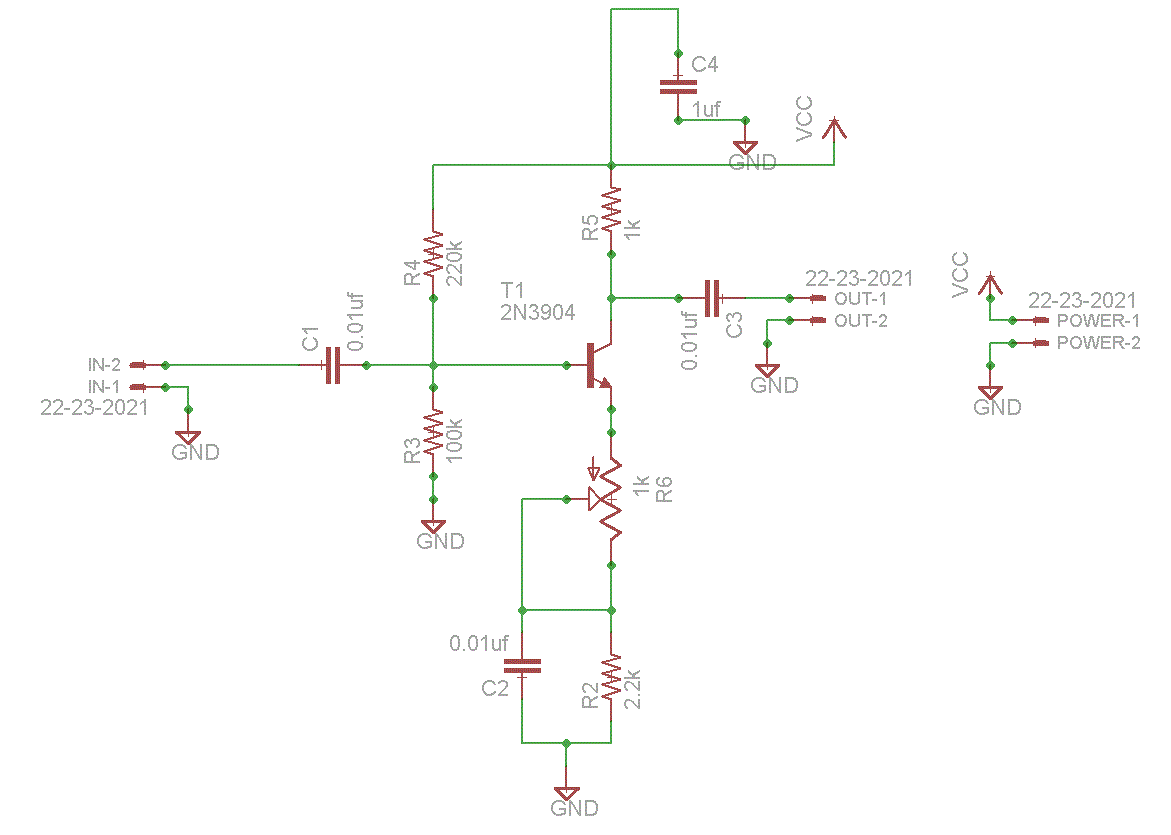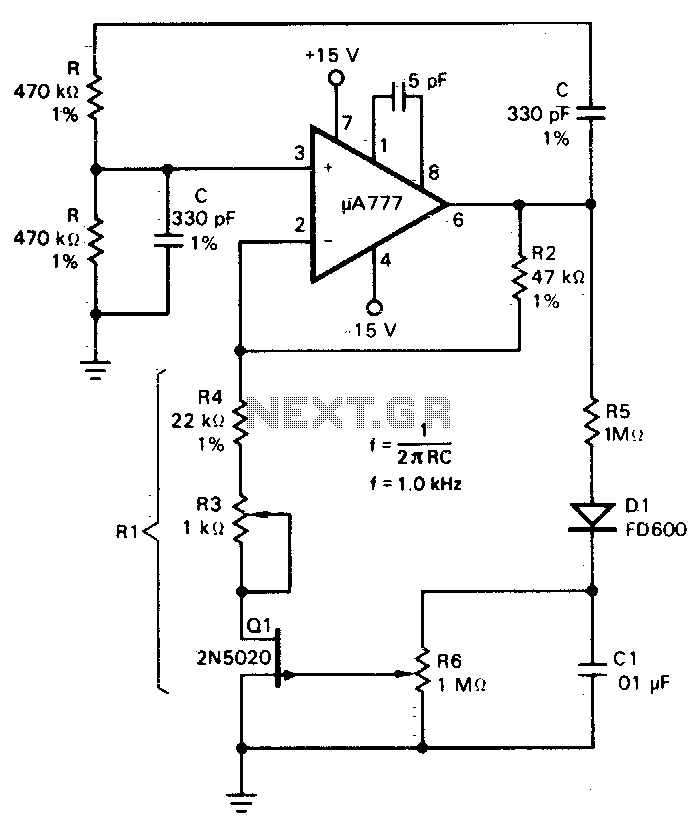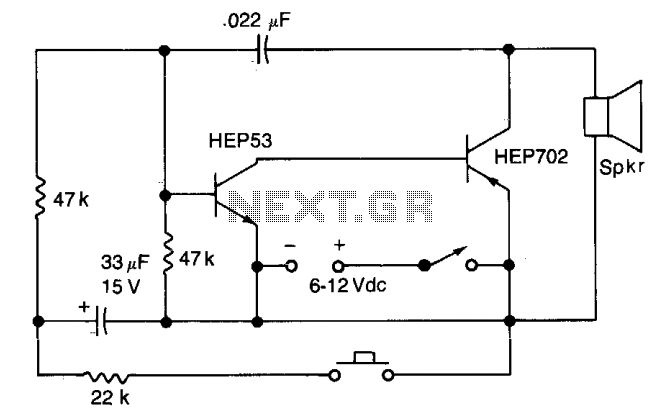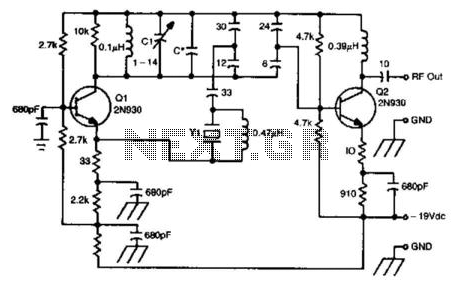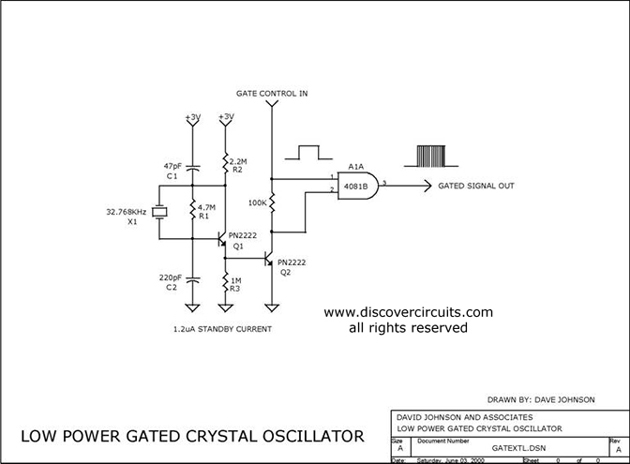
Crystal Oscillator
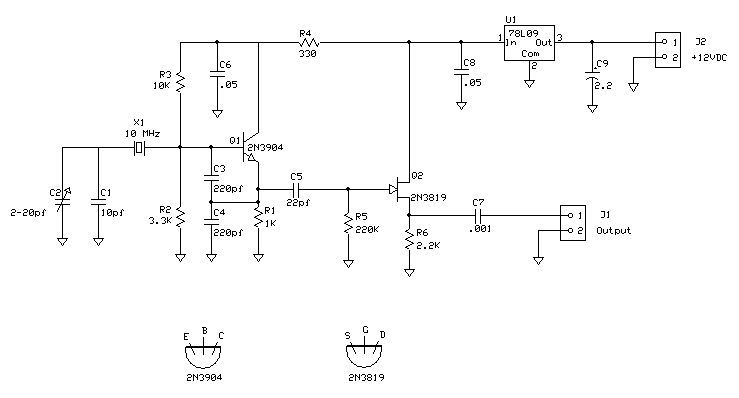
There are three oscilloscopes currently available: an older optoelectronics Opto-7000 that is rarely used, a newer Mitronics MIC-1028, and a recently acquired used Tektronics 2236 oscilloscope purchased at Dayton in 2009, which features a built-in frequency counter. During a recent project, it was observed that the frequency counters on the Tektronics and Mitronics oscilloscopes were not in agreement. To check the calibration, a 10 MHz crystal oscillator was constructed. Various crystal oscillator circuits can be found online, some of which are quite complex. A simple design was desired that did not include tuned circuits and could be adjusted for frequency accuracy. A shortwave receiver was utilized, tuned to WWV at 10 MHz, with adjustments made to capacitor C2 to achieve a zero-beat with WWV. This adjustment is most easily detected when the tones are present, as mis-tuning alters the sound of the tones. Once zero-beat is achieved, the frequency counter should also read 10 MHz. The Tektronics was confirmed to be accurate, while the Mitronics required adjustment, which was straightforward due to the accessibility of the calibration trimmer through a small hole in the front panel. Following the completion of this project, an article was discovered detailing a method to calibrate a frequency counter with an internal 10 MHz oscillator using minimal additional equipment, aside from a receiver for WWV. However, this method did not work with the Mitronics counter, indicating it likely uses a different reference oscillator frequency.
A 10 MHz crystal oscillator circuit can serve as an effective calibration tool for frequency counters in oscilloscopes. The circuit typically consists of a crystal, a few passive components, and an operational amplifier or a transistor configured as an oscillator. The crystal serves as the frequency-determining element, while the operational amplifier or transistor amplifies the oscillation to a usable signal level.
To build a simple 10 MHz crystal oscillator, a fundamental circuit design includes a quartz crystal rated for 10 MHz, a capacitor (C1) connected in parallel with the crystal to stabilize the oscillation, and a feedback resistor (R1) to provide the necessary gain. An additional capacitor (C2) can be included in the circuit for fine-tuning the frequency output. The output of the oscillator can be connected to a frequency counter or a shortwave receiver for calibration purposes.
When tuning the oscillator, the shortwave receiver should be set to the WWV frequency of 10 MHz. By adjusting capacitor C2, the oscillator can be fine-tuned until a zero-beat condition is achieved, where the tone generated by the oscillator matches the tone from the WWV signal. This method provides a straightforward way to confirm the accuracy of frequency counters in oscilloscopes, ensuring that they are properly calibrated for precise measurements.
In conclusion, constructing a simple 10 MHz crystal oscillator can be a valuable project for verifying the calibration of frequency counters in oscilloscopes. This approach not only aids in ensuring measurement accuracy but also enhances understanding of oscillator design and operation.I currently have three: a really old optoelectronics Opto-7000 which I don`t use much, a newer Mitronics MIC-1028, and my most recent acquisition, a used Tektronics 2236 `scope purchased at Dayton 2009, which has a very handy frequency counter built-in. I was working on a recent project and found the Tektronics and theMitronics counters were annoyingly out ofagreement.
How to check the calibration So I built this 10 MHz crystal oscillator. There are a lot of crystal oscillator circuits if you search the internet, some of them amazingly complex. I wanted one that was simple, had no tuned circuits, and could be tweaked to get it on frequency. I use my shortwave receiver tuned to WWV at 10 MHz. I adjust C2 to zero-beat with WWV. This can most easily be heard when the tones are present, since mis-tuning makes the tones sound wierd.
Once zero-beat, the frequency counter should read 10 MHz too. I found my Tektronics was spot on, and theMitronics needed adjustment, which was easy to do since the calibration trimmer was accessible through a small hole in the front panel. Since completing this project, I came across an interesting article on how to calibrate a counter (that has an internal 10MHz oscillator) without any extra gear (besides a receiver for WWV).
Have a look at VE2ZAZ`s blog. It doesn`t work with my Mitronics counter, though, so it must use a different reference oscillator frequency. 🔗 External reference
A 10 MHz crystal oscillator circuit can serve as an effective calibration tool for frequency counters in oscilloscopes. The circuit typically consists of a crystal, a few passive components, and an operational amplifier or a transistor configured as an oscillator. The crystal serves as the frequency-determining element, while the operational amplifier or transistor amplifies the oscillation to a usable signal level.
To build a simple 10 MHz crystal oscillator, a fundamental circuit design includes a quartz crystal rated for 10 MHz, a capacitor (C1) connected in parallel with the crystal to stabilize the oscillation, and a feedback resistor (R1) to provide the necessary gain. An additional capacitor (C2) can be included in the circuit for fine-tuning the frequency output. The output of the oscillator can be connected to a frequency counter or a shortwave receiver for calibration purposes.
When tuning the oscillator, the shortwave receiver should be set to the WWV frequency of 10 MHz. By adjusting capacitor C2, the oscillator can be fine-tuned until a zero-beat condition is achieved, where the tone generated by the oscillator matches the tone from the WWV signal. This method provides a straightforward way to confirm the accuracy of frequency counters in oscilloscopes, ensuring that they are properly calibrated for precise measurements.
In conclusion, constructing a simple 10 MHz crystal oscillator can be a valuable project for verifying the calibration of frequency counters in oscilloscopes. This approach not only aids in ensuring measurement accuracy but also enhances understanding of oscillator design and operation.I currently have three: a really old optoelectronics Opto-7000 which I don`t use much, a newer Mitronics MIC-1028, and my most recent acquisition, a used Tektronics 2236 `scope purchased at Dayton 2009, which has a very handy frequency counter built-in. I was working on a recent project and found the Tektronics and theMitronics counters were annoyingly out ofagreement.
How to check the calibration So I built this 10 MHz crystal oscillator. There are a lot of crystal oscillator circuits if you search the internet, some of them amazingly complex. I wanted one that was simple, had no tuned circuits, and could be tweaked to get it on frequency. I use my shortwave receiver tuned to WWV at 10 MHz. I adjust C2 to zero-beat with WWV. This can most easily be heard when the tones are present, since mis-tuning makes the tones sound wierd.
Once zero-beat, the frequency counter should read 10 MHz too. I found my Tektronics was spot on, and theMitronics needed adjustment, which was easy to do since the calibration trimmer was accessible through a small hole in the front panel. Since completing this project, I came across an interesting article on how to calibrate a counter (that has an internal 10MHz oscillator) without any extra gear (besides a receiver for WWV).
Have a look at VE2ZAZ`s blog. It doesn`t work with my Mitronics counter, though, so it must use a different reference oscillator frequency. 🔗 External reference
